The bold and dramatic Calathea is famous for its fancy foliage and stunning variance. Calathea leaves are simply dazzling, and with over 60 different varieties to choose from, it’s a lot of fun picking one (or 10!). Including a Calathea in your houseplant collection is like adding a living work of art to the home.
About Calatheas
These fashionable and trendy houseplants are also known as Prayer Plants due to the way their leaves fold up a night, then unfurl in the morning. Don’t be alarmed when you see the leaves moving! Calatheas are tropical plants from central and South America that became popular as houseplants in the 1970s. Since their introduction, Calatheas have become celebrated for their beauty and rather dramatic behavior.
While Calatheas aren’t exactly the easiest plant to parent, their allure greatly outweighs their finicky nature, and the elegance they project is worth every effort. Calathea are slow growers; smaller specimens are excellent tabletop houseplants. Many will grow quite tall, though, given the opportunity, sometimes reaching up to 3-feet. A grand and statuesque Calathea is quite the statement if you’ve got the space.
Most of the common houseplant Calatheas have recently been moved to the Genus Goeppertia, so you may start seeing them sold under that name, too. In this list, we use Calathea interchangeably with Goeppertia because it is so widely known. Maybe one day, Goeppertia will catch on.
19 Spectacular Calathea Varieties
Here are 19 of our favorite Calathea varieties that you can keep at home:
Rosy (G.roseopicta)
The large, oval green leaves with deep pink centers of the Rosy Calathea are just gorgeous. It isn’t just the bright coloring on top of the leaves that make this Calathea stand out; the undersides are a rich, dark purple. The Rosy Calathea adds spark and color to the home with its bold complexion. It is a smaller Calathea, averaging 15-20 inches tall.
Pinstripe Plant (G.ornata)
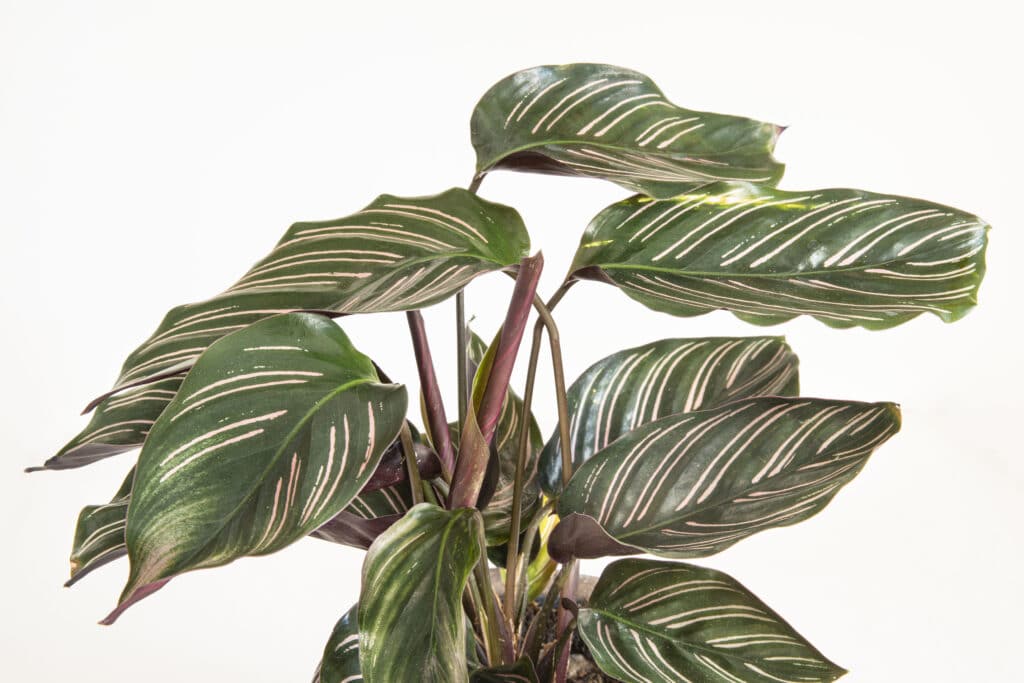
Deep green lance-like leaves with thin electric pink stripes give this popular variety its common name. The striping looks like it’s been painted on, intricate detailing done with a fine paintbrush. Pinstripe Plants can get quite tall, given the opportunity – they grow 3-9 feet in the wild. The foliage is sizeable, too, the leaves elongated and eye-catching with maroon undersides. As the leaves age, the pinstriping often fades to white or yellow.
Rattlesnake Plant (G.insignis)
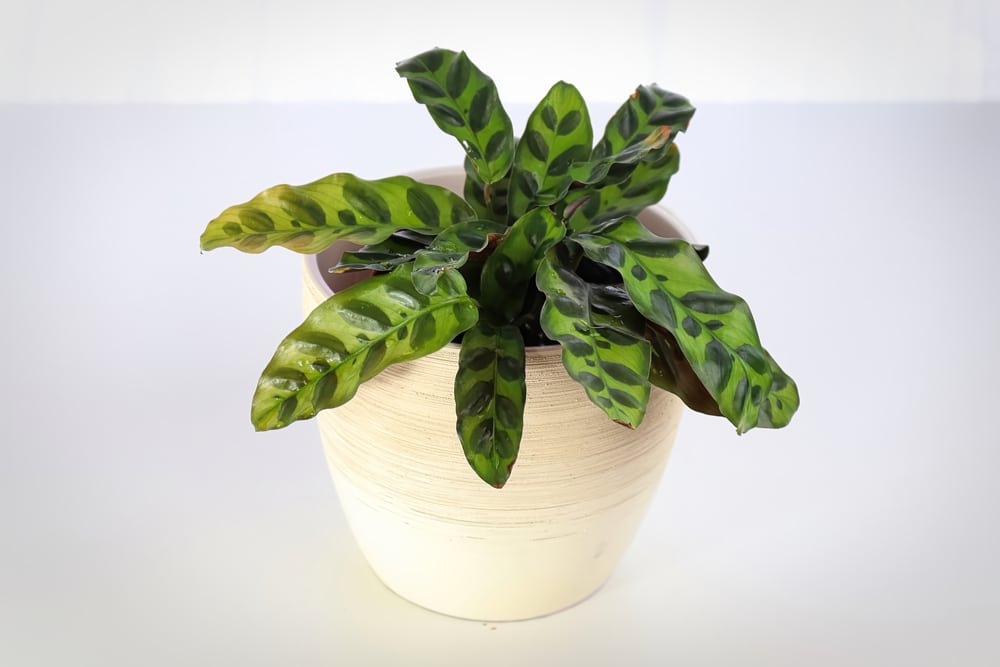
With long, narrow ruffled leaves that grow in a dense habit, Rattlesnake Plant is a true centerpiece plant. The tops of the leaves are light green and heavily marked with dark green spots arranged opposite each other along the ribs. Rattlesnake Plant leaf undersides are a rich burgundy, offsetting the green exceptionally. This Calathea grows smaller than others, averaging 24-30 inches tall.
Round-Leaf Calathea (G.orbifolia)
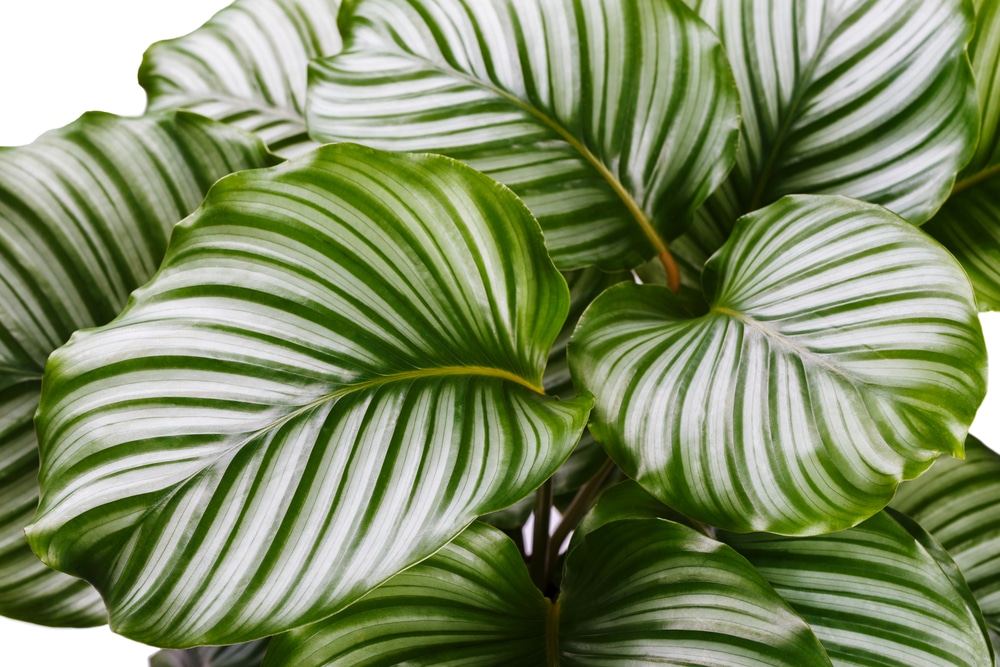
The oversized brilliant green leaves of Round-Leaf Calathea are stripped with silver and many shades of green, creating a bold and radiant display. The foliage is rounded and crisp-looking and grows in an outstretched fashion, demanding to be seen and admired. Adding to the allure, this Calathea features silvery-green undersides. The Round-Leaf Calathea grows 2-3 feet tall indoors, given a chance.
Medallion (G. veitchiana)
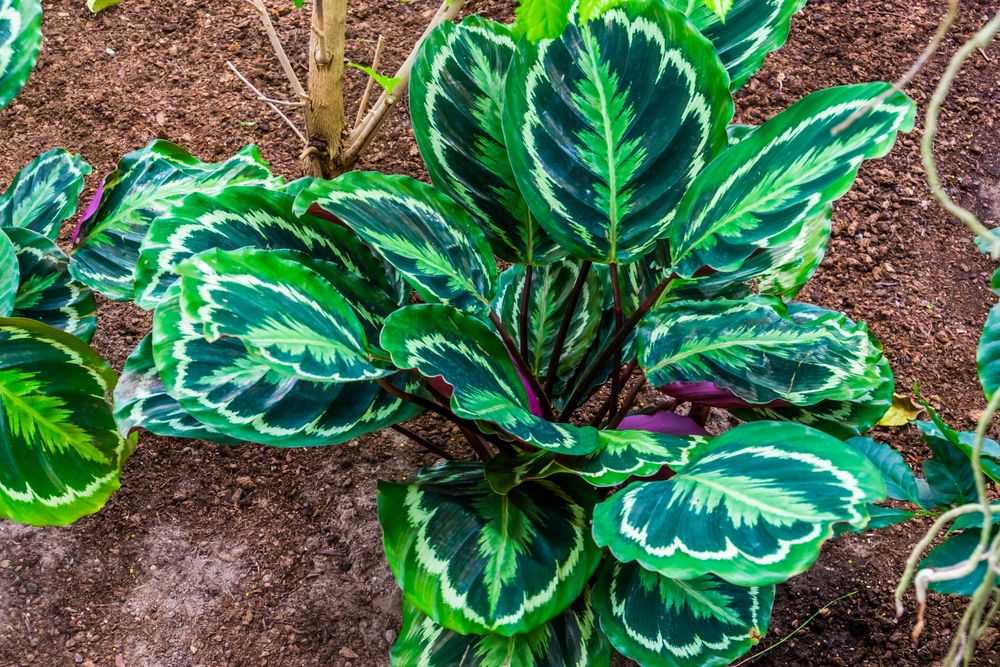
A grand Calathea that effortlessly earns its common name, Medallion features large, rounded leaves with intricate green and white markings. The foliage pattern is reminiscent of a peacock feather, with alternative light green, dark green, and white striping. Leaf undersides are vivid purple-pink. The Medallion Calathea is small, growing between 6-36 inches tall.
Corona (G. roseopicta)
Featuring broad silvery-green leaves with dark green edges, Corona is a unique and sophisticated Calathea. The leaf undersides and stems are purplish red, making an impressive statement when the Corona folds up at night. Many leaves retain a deep red stripe down the midrib. The contrast is exceptional with this cultivar. Corona averages 12 inches tall and wide and is perfect as a desk accent.
Beauty Star (G.ornata)
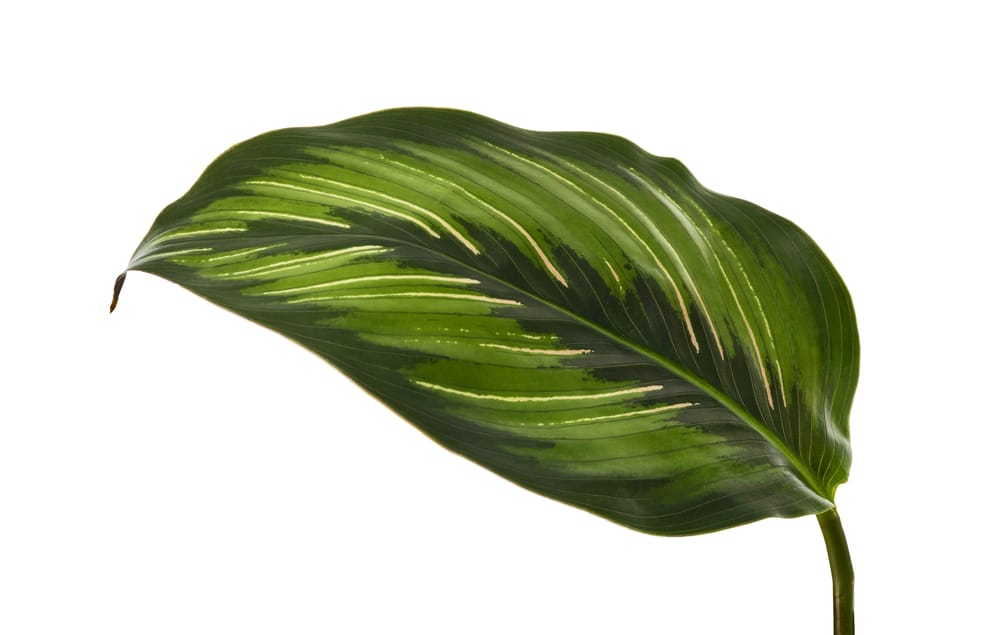
A showstopping Calathea hybrid, Beauty Star boasts long, narrowed, emerald green leaves with light green, silver, and white patterning. The foliage is flamboyantly decorated with a feather-like design; the leaves have broad light green patches with intricate silver and pink lines. Beauty Star foliage is deep purple underneath and lengthier and thinner than most Calatheas. The growth habit is reasonably dense, and it grows up to 2-feet tall and wide.
Jungle Velvet Plant (G. warszewiczii)
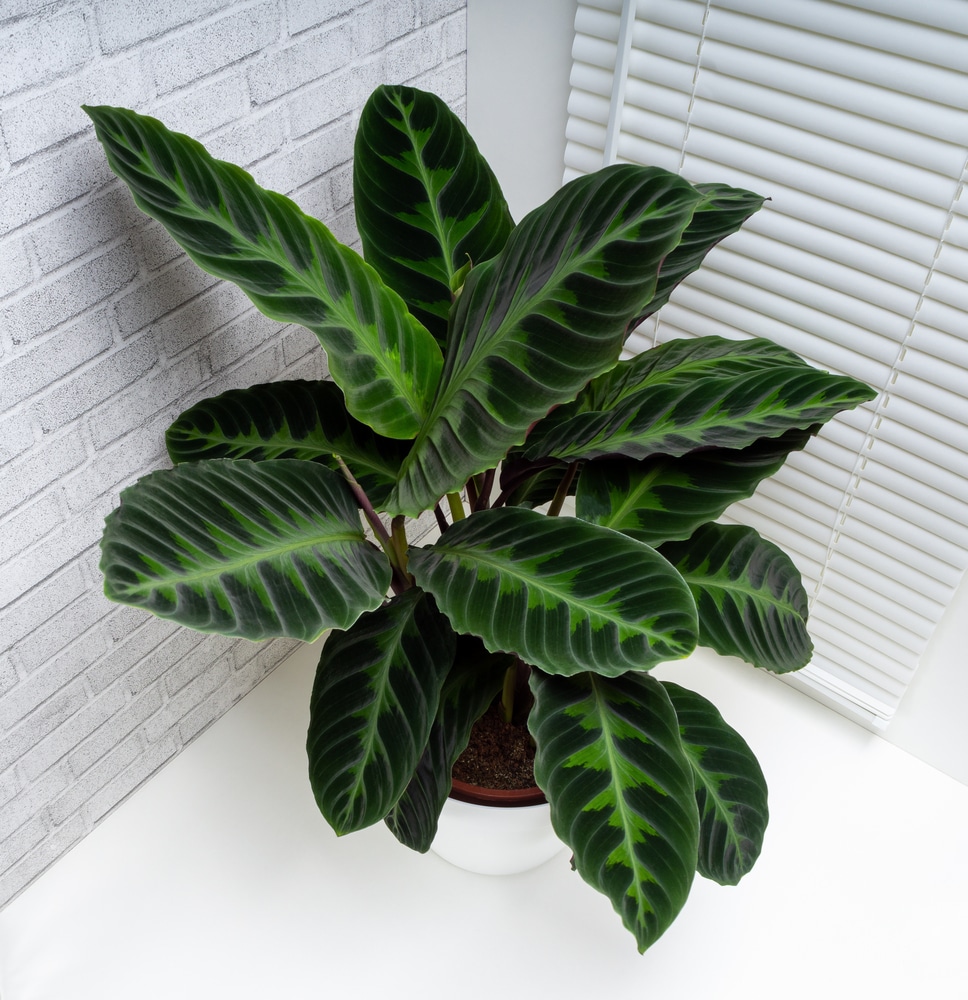
The velvet-like leaves and majestic patterning make the Jungle Velvet Calathea a one-of-a-kind houseplant. It’s hard to resist touching the leaves every day; the velvety foliage is exceptional. Each leaf is highlighted with a jade and light green fishtail pattern, and the underneaths are deep maroon. Jungle Velvet Calatheas average 20-40 inches high and wide.
Network (G.musaica)
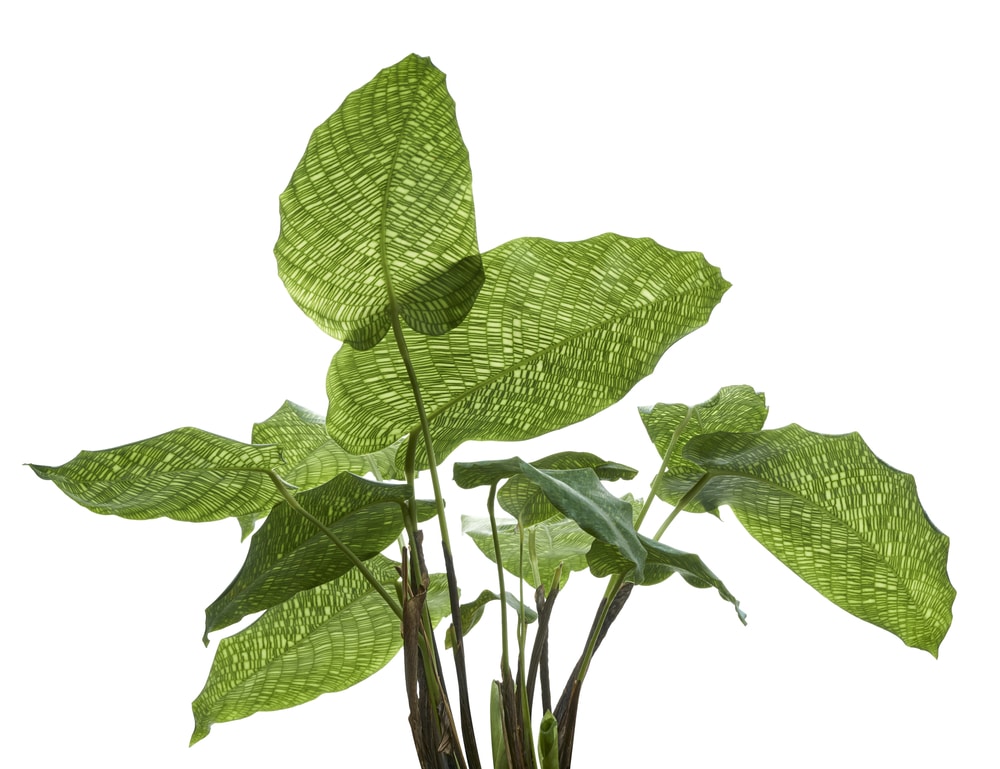
A bit more understated than other Calatheas, the Network variety is still spell-binding. The foliage is a light and dark green mosaic, and the leaves are ultra glossy. Network Calathea leaves are ruffled along the edges and arch slightly to form an attractive clump. The mosaic or network effect is especially striking when the leaves are backlit. This new hybrid cultivar is captivating all who see it with its finely drawn patterning.
Argentea (G.picturata)
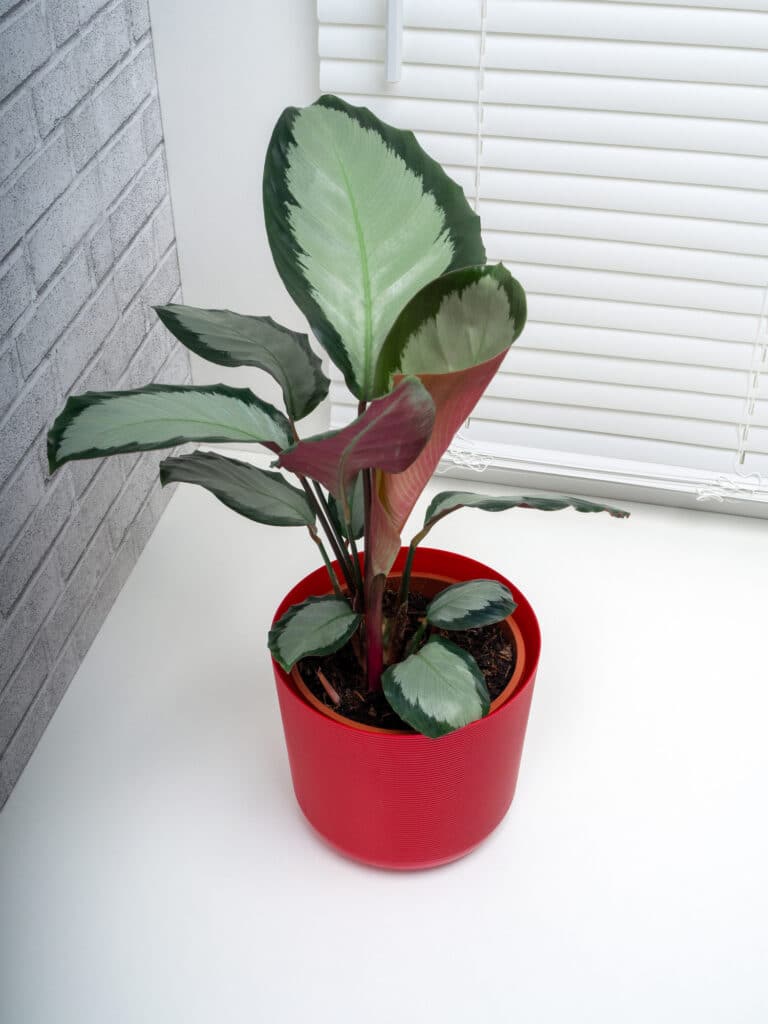
Calathea Argentea leaves feature a large silvery green center with a deep dark green band around the edges. The contrast on these broad, oval leaves is glorious and striking. Argentea leaf undersides are wine red, as are the tall stems. This Calathea variety grows up to 2 feet tall and retains a bushy, upright growth habit.
White Fusion (G. lietzei)
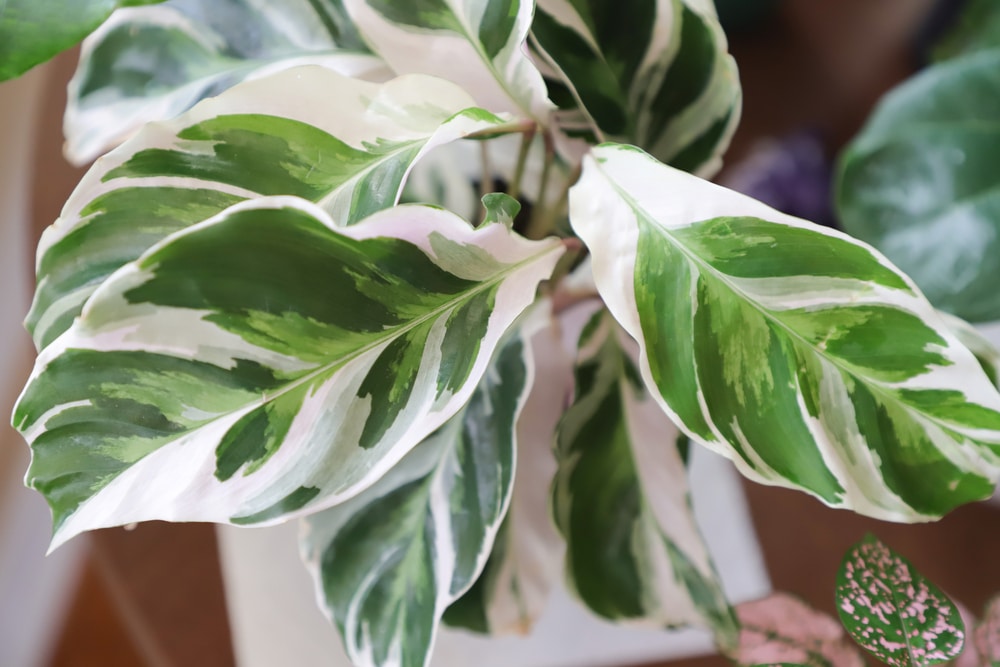
The broad teardrop-shaped leaves of White Fusion are marbled in streaks of green and snow-white on top and are pale purple underneath. White Fusion marbling varies with each new leaf, creating a gorgeous medley of bold colors and intrigue. This new Calathea cultivar grows upright and bushy, averaging 1-1.5 feet tall and wide.
Freddie (G.leopardina)
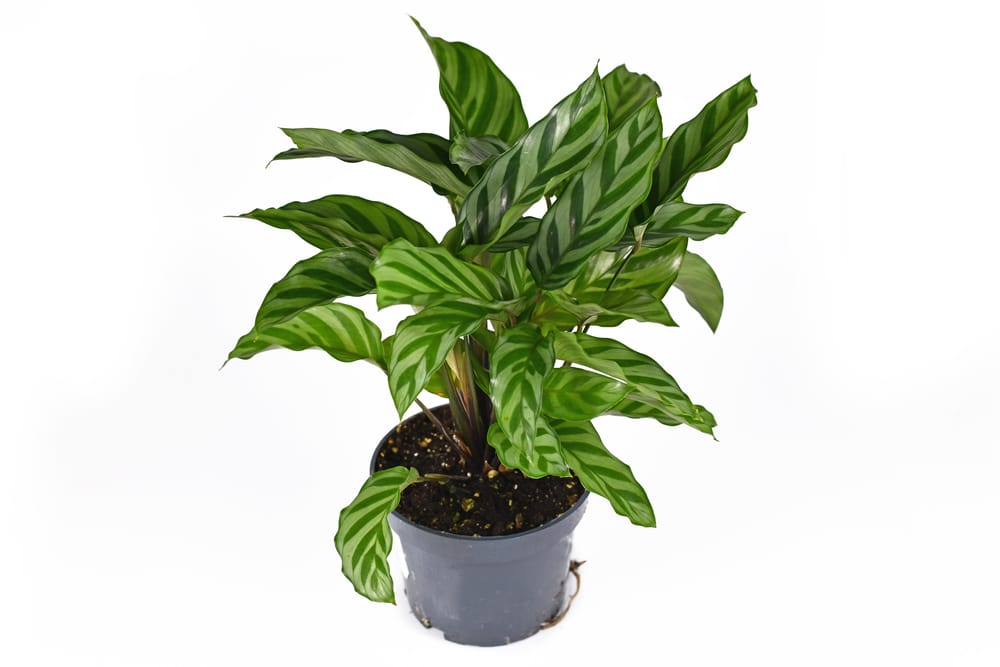
A remarkable Calathea with bold dark and light green markings, Freddie is also known as the Leopard Calathea. Freddie foliage is elongated with pointed tips. The leaves are pale green with dark green outstretched spots or stripes. These dark-green markings appear intermittently up the midrib, giving the appearance of a painted tail feather. It is one of the few Calatheas leaves with green undersides.
Furry Feather, Velvet Calathea (G.rufibarba)
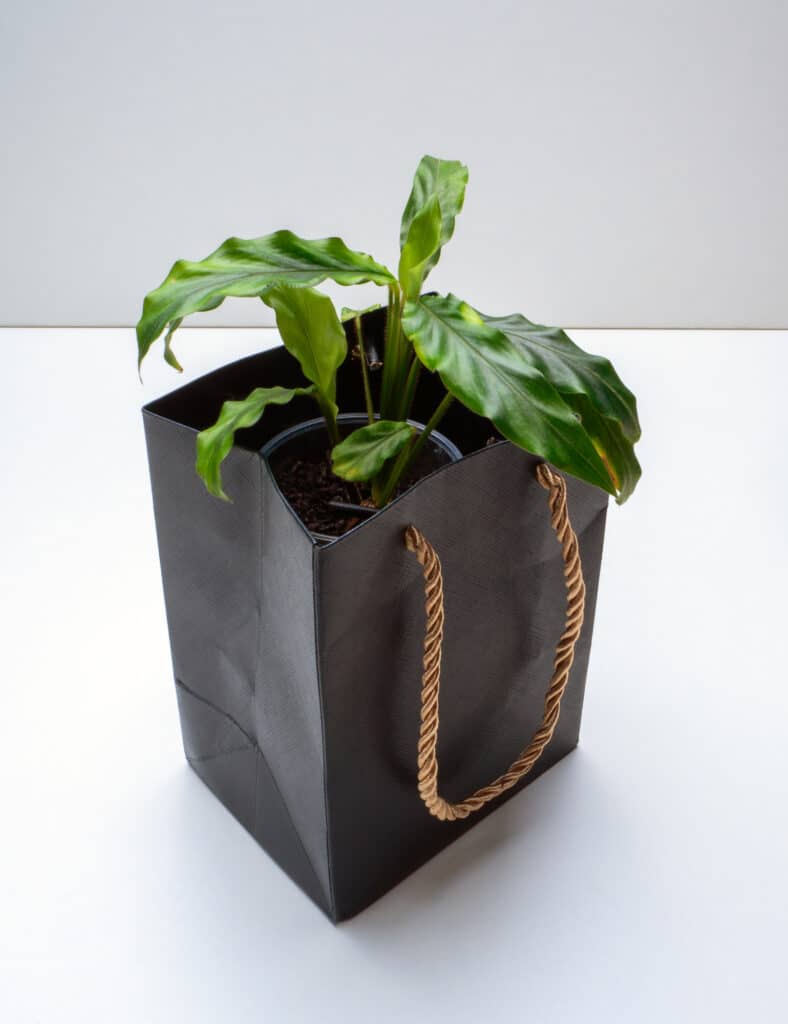
Named for its fuzzy underleaf texture, a very unusual feature of Calatheas, Furry Feather is a fun and peculiar houseplant. The elongated lance-shaped leaves are bright green on top and deep purple underneath, and the stems are burgundy. Furry Feather plants reach up to 3 feet tall and are perfect for adding flair to the living space.
Thai Beauty (G.louisae)
Sporting a variegation pattern that is striking, to say the least, Thai Beauty is new to the houseplant world but sure to become a fast favorite. Thai Beauty foliage is intermittently dark-green, lime green, and cream, with each leaf featuring a pattern unique to itself. The undersides of the leaves are a deep purple, adding a rich element to the color medley. Every time a new leaf blooms, it’s an adventure.
Dottie (G.roseopicta)
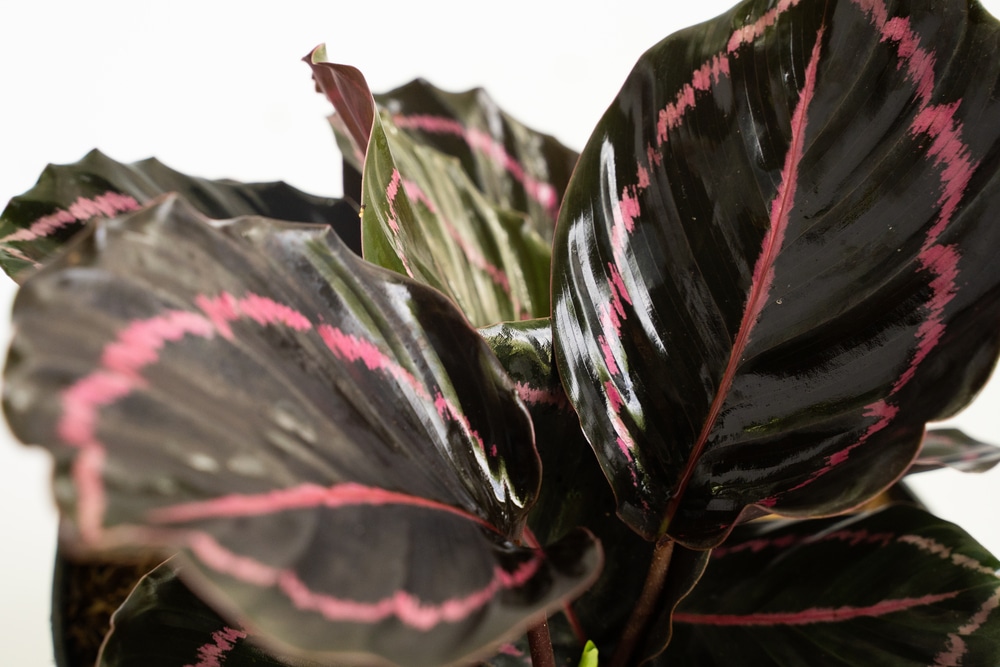
With foliage so dark green it almost looks black, it’s easy to understand why Calathea Dottie is so popular. Each leaf is outlined with a bright fuchsia pink band and has a dark purple underside. Not the flashiest of Calatheas, but equally captivating for its muted coloring, Dottie wins hearts wherever she sits. This Calathea averages 15-25 inches tall; it is one of the smaller varieties.
Elliptica (G.vittata)
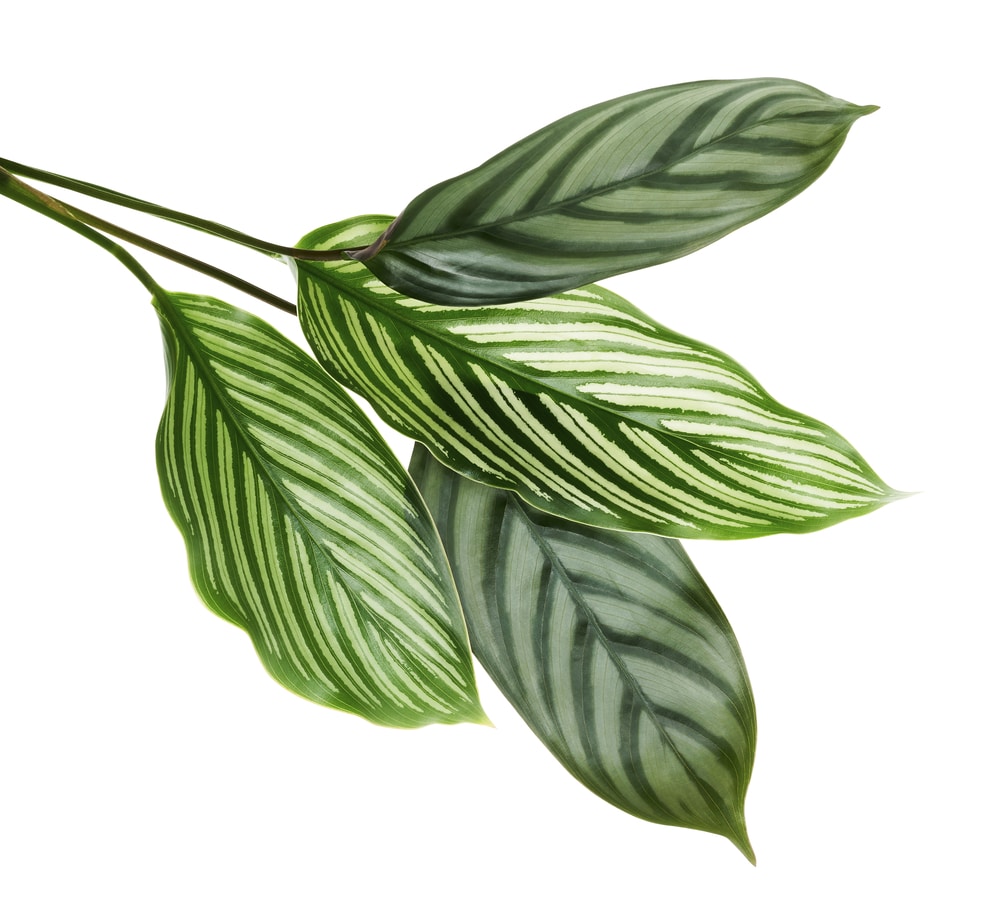
Elliptica Calathea shines with dark green elliptic striped foliage. The leaves are boldly patterned, with delightful thick brushstroke stripes. The markings are either yellow or cream-colored and vary slightly depending on light conditions. Calathea Elliptica’s growth is upright and clumping and reaches up to 18 inches tall and wide. This Calathea commands attention; it’s a perfect plant for the office.
Misto (G. “Misto”)
The elegant Calathea Misto is a hybrid with medium green leaves and light and dark green brush strokes. Its leaves are broad, slightly elongated, and somewhat scalloped. The leaf undersides are deep burgundy. Misto grows 2-3 feet tall and is full of wonderful Calathea character.
Peacock Plant (G.makoyana)
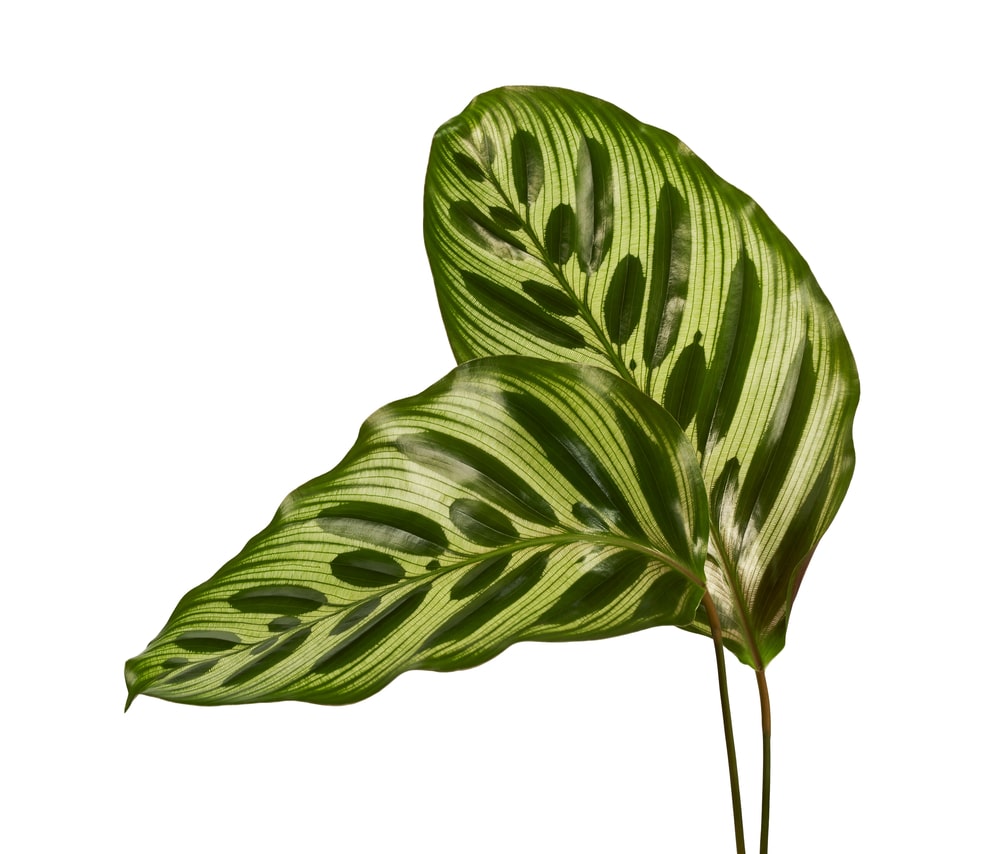
The quintessential Calathea, Prayer Plants are the most popular variety for a good reason – they’re stunning. Prayer Plant foliage is a glossy emerald green with light green feathering and dark green brushstrokes at the midrib. Foliage is deep purple underneath. Prayer Plants are also known as Cathedral Windows because they bring a stained glass window to mind. This Calathea is also popular because of its smaller size compared to other Calatheas, growing to 18 inches tall. This is the perfect countertop houseplant, beautiful and compact.
Zebra (G.zebrina)
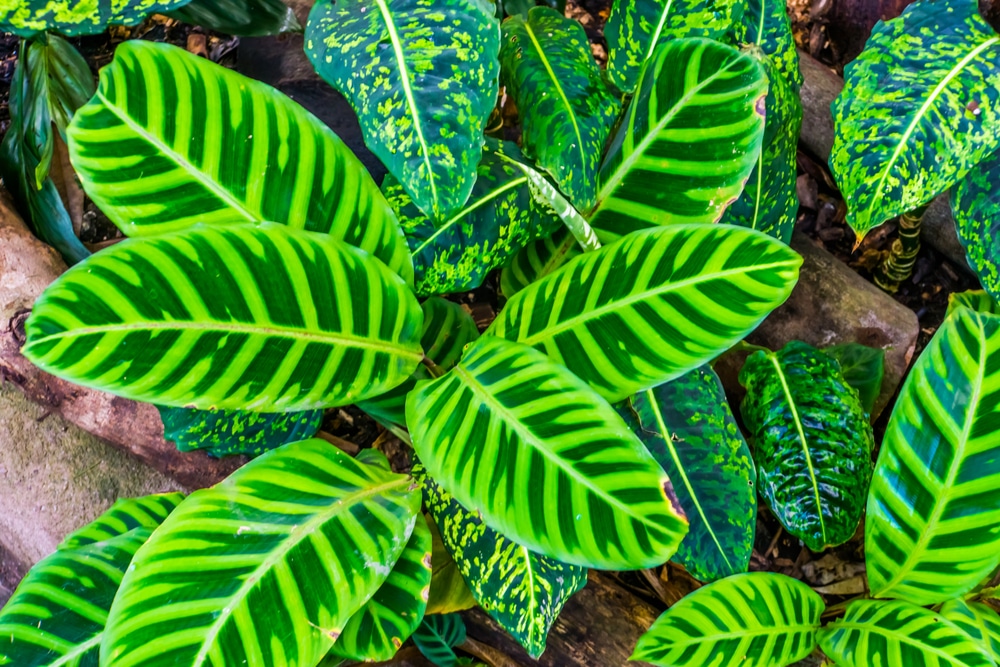
The foliage of the Zebra Calathea is dark-green with lime green markings along the veins and margins. The design is so perfectly arranged that it looks like it was stamped onto each leaf. With Zebra Calathea’s two-tone color and striping pattern, it’s easy to see how it got its common name. The leaves are dark red underneath and grow quite elongated, averaging 12 inches long. This Calathea will grow up to 3 feet tall.
Basic Calathea Care
No matter which Calathea you get, the care instructions are basically the same. They are all tropical houseplants that adore lots of humidity and warmth. Calathea plants are known to be a bit picky; they are the drama queens of the houseplant world. Their upkeep isn’t difficult if you pay attention to them and provide the proper elements. Calatheas are not houseplants that want to be ignored.
Light
All Calathea thrive on bright, indirect light. Light is essential for the foliage to retain its intricate and exquisite coloring and distinctive patterns. Direct sunlight burns the leaves, so keep them a little away from the window or light source.
If you notice leaves turning white (for varieties without white variegation), your Calathea is receiving too much light. A west or east-facing window is ideal as it provides enough sunlight without overwhelming.
Water
A consistent watering routine is essential for your Calathea. They notoriously get brown leaf tips due to insufficient water or humidity. The soil must be evenly moist at all times. Never let your Calathea dry out; they are not at all drought-tolerant and don’t like to be neglected.
Check the soil every time before watering to ensure your Calathea isn’t being over or under watered. Stick your finger in the dirt; if the top inch of soil is dry, it’s time to water. If the soil is still moist, wait a few more days. At first, this may seem tricky, but over time, you’ll be able to develop a regular watering schedule with your Calathea.
Calathea plants are sensitive to salts and fluoride, so it’s best to use distilled water or rainwater. Alternatively, let your tap water sit for 24 hours before using so many elements, like chlorine, evaporate out.
In the winter, reduce watering as the plants rest and aren’t actively growing.
Temperature & Humidity
Increase humidity by setting up a humidifier or using a DIY humidity pebble tray. To make a pebble tray, line a small pan with stones and fill it with water. Place the plant on top of the rocks; as the water evaporates, moisture in the air increases. You’ll need to refill the tray with water regularly.
Another way to increase humidity is to lightly spray the leaves with water every day or so. Only do this in the morning, so the leaves have time to dry out – this reduces the chance of diseases developing.
Potting Soil & Containers
Always use a container with drainage holes so that the soil can drain properly. Soil that doesn’t drain properly leads to root rot. Avoid terra cotta pots as they absorb too much water, taking moisture from the dirt.
Fertilizer
Apply a general houseplant fertilizer mixed at half strength every 3-4 weeks. The only thing to be wary of is not adding too much. In the winter, only fertilize once a month.
Toxicity
All Calatheas are non-toxic to people and pets.
Calathea are sensational houseplants with impressively patterned leaves that burst with life. A Calathea houseplant is a majestic addition to the houseplant collection.

